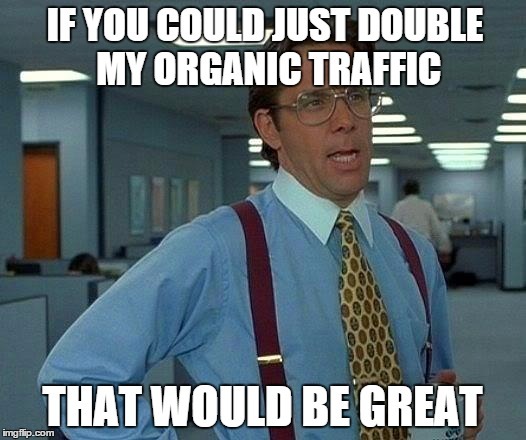Right now, more than 600 million blogs* are floating around the web – with over 8.2 million posts being churned out daily.
*By ‘blog’, I mean a regularly updated website or web page, typically run by an individual or brand.

Using these stats alone (as well as the multitude of LinkedIn influencers preaching their unbridled power) you may be tempted to stop what you’re doing and seek out your nearest blog-building tool. But hold on a minute – what if I told you that over 90% of pages get no organic search traffic from Google? And that, without the right content strategy and writing prowess, you’ll likely send your posts out into the ether to die a sad and lonely death (one that takes away your time, and ultimately, your leads).
Not to worry – I’ll walk you through a few things you can do to write a blog that will grab your reader’s attention, and encourage them to keep reading. And, with time, you’ll make it out of the dreaded 90% club.
Why do we write blogs anyway?
In the modern age, blogs may seem like a bit of a waste of time, so why do we still write them? Well, when done properly, blogs can engage your audience, establish your brand as a voice of authority and even attract more quality leads to all pages of your site. Think of them as your chance to show off your services and knowledge in ways you can’t get away within your service pages.
Every page on your website needs to have a purpose – for the most part, your home and service pages need to be rich in great copy. Including short and sharp headlines, concise content and effective CTAs. Blogs, in contrast, offer your readers longer-form content on topics they may be interested in learning more about. This may include frequently asked questions, deep dives into your methods or even storytelling about your brand. All of these help potential leads get to know who you are, what you do and whether or not you can back up your offering with expertise.
At their most basic level, blogs are our digital megaphones – our soapboxes to stand on and shout “Listen to me!” But let me be clear, if you’re shouting into the void, it’s not helping anyone.
Give the people what they want: it’s all in the data
Writing a great blog is a bit like hosting a party (stay with me here). If you want people to actually show up, you’re going to need to do a few things first. To start with, who are you going to invite? You need to be well aware of your audience, what they want and how to give it to them when they get to you. This is where the data comes in.

Get stuck into your website’s metrics, as well as keyword tools like Semrush and People Also Ask. You need to know what your audience is looking for and what questions they are asking. Next, you need to answer the right questions in the right way to avoid people clicking off. Finally, find out where your audience is gathering and shout about your blog there. If your potential leads are all on Instagram, then posting to LinkedIn isn’t going to help you. To know all of these things, you’re going to need to get up close and personal with analytics.
Get (better at) writing
Unfortunately, Google doesn’t enjoy badly written, keyword-stuffed content anymore. This means you’re going to have to get writing – and get better at writing. For those with no writing experience, you’ll be pleased to know that AI models like Chat GPT can offer you a good place to start. But – and I want to stress this next part – do not rely on them completely!
AI models can offer ideas for content, and, in some cases, give a baseline for a blog. What it can’t do however is write something that people really want to read. If you’ve ever asked Chat GPT a question you’ll know exactly what I mean – the content is either stiff and lifeless or, if you ask it to be engaging, will offer a slew of cliches. Need an example? Here’s the prompt I gave Chat GPT to write a little bit of this blog, and what it gave me:

Please give me an introduction for a blog that’s titled ‘How to write a blog that people will actually read’. The tone should be informal, engaging and slightly tongue-in-cheek:
“Blogs are like a secret handshake with the universe … So, when you write a blog, you’re basically a cyber superhero, swooping in to rescue these knowledge-hungry souls. Pretty cool, right?”
Need I say more? Now, there are a few things that I recommend you do to improve your writing. First, take a look at what other people are doing. This isn’t about copying, plagiarism isn’t the way to go. But look at the tone of voice they use, what topics they cover and how much engagement their content gets. Next, get your work into a tool like the Hemingway App. Here, you’ll get a bit more information about what is currently wrong with your content and how to improve it – making your blog posts much more engaging overall.
Write a killer headline
In the world of content, attention is our currency. It’s the whole reason why we write – to interrupt an individual’s busy day with a headline that sparks curiosity or encourages a click. Your headline is your one chance to grab the attention of your audience in a world saturated with information, and you need to get it right.
Again, you need to go back to your audience. Know exactly who you are speaking to – and tell them exactly what you’re offering. Next, get into the data and grab those keywords from earlier. If you know what your audience is asking, you can make sure they know you’re about to answer it.
Lastly, get creative and get focused. Your headline should be clear and to the point. It should say “Here is what you will learn.” Write out a list of possible headlines, get feedback from others, and make sure you’re crafting your words to specifically grab attention.
SEO like the pros
Now, if you’ve followed me so far, you should have a well-written blog that’s tailored to your specific audience – and you should have a killer headline that people will want to click. There’s just one part of the puzzle missing, and that, my friend, is SEO.

Understanding SEO will need its own dedicated blog, but in essence, SEO (search engine optimisation) is a set of practices aimed at improving a website’s visibility in search engine results, making your content more likely to appear higher in organic (non-paid) search rankings. It involves optimising various elements of a website, such as content, keywords, and backlinks, to attract more organic traffic and enhance its online presence.
How can you optimise SEO within your blog posts? Go back to your keywords and write yourself a list of words that you would like to target. These should be tailored to your audience’s specific needs, as well as how well they are ranking.
Once you have your keywords, sprinkle them into your content. Do not, and I repeat, do not stuff your content with keywords. Instead, optimise your headlines and content higher up on the page. Focus on incorporating the keywords naturally into your writing so that engagement doesn’t suffer. A little tip is to get the percentage of keywords within your content to be about 1-2%.
Keep your expectations realistic: blog success will not happen overnight.
There is one final point I would like to make, and it’s an important one: you need to manage your expectations. Your first blog post will not be successful. Why? Because your SEO strategy, including page authority, will take time to get working. In fact, the average page in the top 10 on Google is 2+ years old.
What can you expect then? Well, you can expect a few people to actually read your post. If you’re doing things the right way and writing with data in mind, you can also expect a slight uptick in website visitors. And, with the right mix of page authority, content value and time, you’ll start to see more leads rolling your way.
Overall, when used correctly alongside an overarching SEO and content strategy, blogging can be a great way to show off your brand’s expertise, advertise your services, provide value to readers and generate some ROI.
If you’d like to learn a bit more about creating a blog that your readers will love, let’s chat!